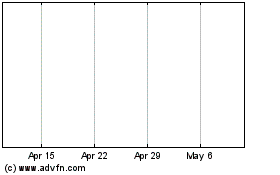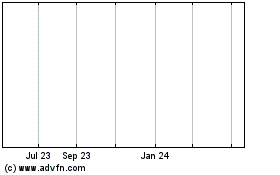By Alison Sider
Halliburton Co. and Baker Hughes Inc. are planning to call off
their merger, once valued at nearly $35 billion, which encountered
opposition on multiple continents from regulators who claimed that
it would hurt competition in the oil-field services business.
The announcement of an end to the merger agreement could come as
soon as Sunday evening, according to people familiar with the
matter.
The deal to combine the world's second- and third-largest
oil-field services firms after Schlumberger Ltd. appeared
increasingly troubled since April 6, when the U.S. Justice
Department filed a lawsuit to block it. The merger had also
encountered opposition from regulators in Europe.
The companies had anticipated regulatory challenges when they
originally struck their agreement in 2014, but repeatedly stressed
that they felt the obstacles could be overcome, even as analysts
and other experts questioned the risk.
The two sides previously set April 30 as the day when the
agreement expired, allowing either to walk away from the deal.
After Halliburton announced first-quarter operating results but
postponed a discussion of its earnings until May 3, analysts
speculated that the merger was in trouble.
Halliburton will have to pay a $3.5 billion break-up fee to
Baker Hughes -- a condition of the merger agreement put in place in
a nod to anticipated regulatory challenges.
The Justice Department suit argued that the deal would eliminate
head-to-head competition in as many as 23 product lines, which
would lead to higher prices and less innovation.
At the time, both companies were aggressive in their pledges to
fight back, saying that they believed they could disprove the
Justice Department's allegations in court. They sought to have the
case heard in Texas, where some analysts said they'd be more likely
to prevail.
While the companies' efforts to sell off business had left
anti-trust officials unmoved, Halliburton moved forward in serious
talks with Carlyle Group, a private-equity firm with a long track
record of creating standalone businesses from the cast-offs of
larger companies.
Halliburton announced late last week that it would take a $2.1
billion restructuring charge to its first quarter earnings,
relating to severance costs from layoffs and writing of the value
of some of its assets, like older fracking pumps that are no longer
being used.
In the past, Halliburton has said it had to keep some excess
infrastructure in place, despite the downturn, to be ready to
integrate Baker Hughes and quickly ramp up as a combined
company.
Thanks to the breakup fee, a newly independent Baker Hughes
would be flush with cash, which some analysts have said will give
it the cushion it needs to retrench. But a failed deal also
presents existential challenges for the company, which was formed
in 1987 through the merger of Baker International and Hughes Tool
Co., which was founded by the father of billionaire aviator,
inventor and Hollywood tycoon Howard Hughes Jr.
The elder Howard Hughes patented a new drill bit with two
rotating cones that could chew through hard rock, allowing drillers
to reach oil deeper below the Earth's surface than they ever had
before.
Even today, Baker Hughes is considered a leader in developing
new technologies for the oil patch. But the company has struggled
in its newer ventures into businesses such as fracking, which
require mastery of vast supply chains and logistical challenges,
analysts at Piper Jaffray Co. said.
And the company's struggles have been compounded by a year in
limbo, tethered to Halliburton.
Oilfield services firms, which are hired to drill and frack
wells, were among the first to feel the pain from lower oil prices,
and have been forced to make some of the deepest cuts. Most are
losing money in big markets such as North America.
But Baker Hughes has been constrained by its merger agreement
from making sweeping changes without Halliburton's approval. The
company said this week that it carried $110 million of costs during
the first quarter that it wasn't able to cut because of the merger,
contributing to its $981 million loss.
With the merger scuttled, "the company can begin restructuring
and stripping these excess costs from the system," Raymond James
analysts wrote last week, anticipating that the deal would be
called off.
For the rank-and-file at Baker Hughes, the slow-moving merger
compounded the uncertainty created by plummeting oil prices, and
many of those who could find other jobs have left, according to
analyst reports and interviews with former employees.
Still, many analysts believe that all the hand-wringing about
Baker Hughes's fate is overblown: Standing on its own, the company
could shake off the malaise that has plagued it in the last year.
Unlike many of its peers, Baker Hughes will have a $5 billion cash
war chest to spend if oil prices recover and activity ramps up, so
it could rebuild and could come out swinging.
"Independently, Baker would quickly become a turnaround story,"
Evercore ISI analyst James West recently wrote.
Baker Hughes may get a push from the outside. ValueAct Capital
Management, an activist hedge fund, bought Baker Hughes shares
shortly after the merger was announced. In April, the fund
disclosed that it increased its stake and is now Baker Hughes's
largest shareholder, with 9% of its shares.
ValueAct has previously pushed for Baker Hughes to consider
breaking itself up and seeking other buyers if the merger falls
apart, according to a lawsuit brought by the Justice Department
over how ValueAct disclosed its initial stake in the company. And
the fund has already signaled that it won't sit by quietly as Baker
Hughes gets its house in order. In a recent securities filing,
ValueAct indicated that it may seek a seat on the company's
board.
Write to Alison Sider at alison.sider@wsj.com
(END) Dow Jones Newswires
May 01, 2016 18:17 ET (22:17 GMT)
Copyright (c) 2016 Dow Jones & Company, Inc.
Halliburton (NYSE:HAL.WD)
Historical Stock Chart
From Mar 2024 to Apr 2024

Halliburton (NYSE:HAL.WD)
Historical Stock Chart
From Apr 2023 to Apr 2024
